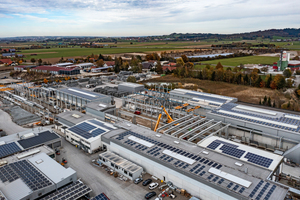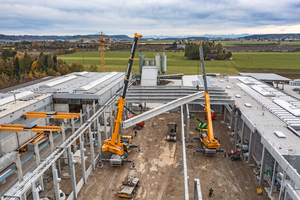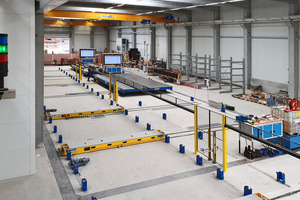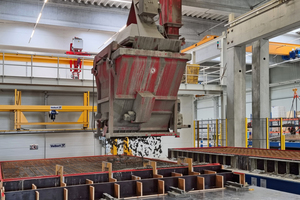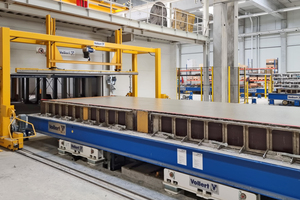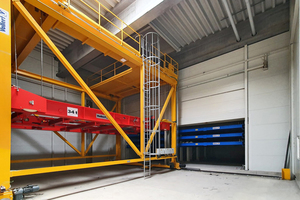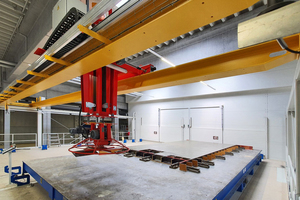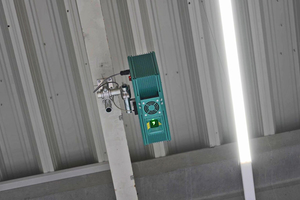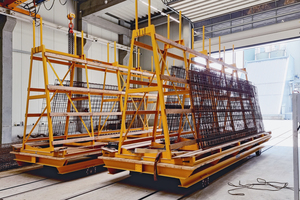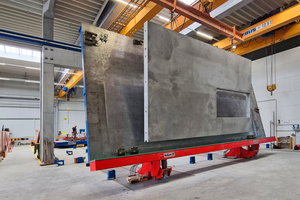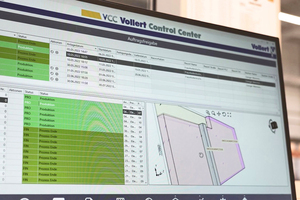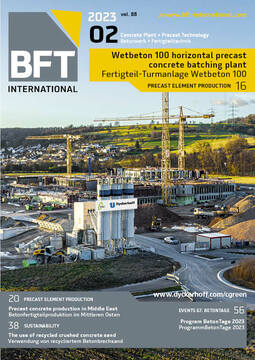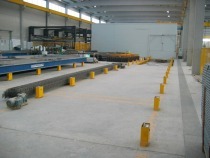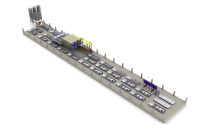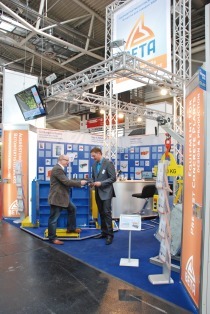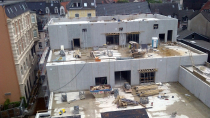Construction in existing building structures: Unglehrt automates precast concrete production
Whether concrete products for gardening and landscaping or walls, beams and columns - the traditional company Unglehrt has been producing high-quality concrete parts for more than 100 years. In order to further increase competitiveness, the company has now invested in an automation of the existing precast concrete production at the plant location in Bad Grönenbach, Bavaria.
Whether concrete products for gardening and landscaping or walls, beams and columns - the traditional company Unglehrt has been producing high-quality concrete parts for more than 100 years and also specializes in turnkey commercial and industrial construction. In order to further increase competitiveness and also to have answers to the increasing shortage of skilled manpower, the company has now invested in an automation of the existing precast concrete production at the plant location in Bad Grönenbach, Bavaria.
„We have a very versatile setup. Here at the factory location in Bad Grönenbach in the Allgäu region, we produce not only concrete products such as paving blocks, manhole rings and angle support elements, but also prestressed concrete components such as structural column and beam elements as well as solid and sandwich walls for our construction projects. These range from modern office and administrative buildings to multifunctional logistics centers,“ explains Roland Albrecht, Technical CEO at Unglehrt. In the past, the company mainly relied on stationary solutions, combined with a high proportion of manual work.
„The construction industry and we, of course, as a construction company, are facing major challenges, especially social challenges such as climate change, the creation of sustainable construction processes and resource-conserving manufacturing processes with the lowest possible CO2 footprint. But the shortage of skilled manpower is also becoming increasingly problematic, and has been for a long time in the construction sector. And in this respect, automation of processes is indispensable and a basic prerequisite for remaining competitive,“ says Roland Albrecht. Against this background, the decision was made at the end of 2020 to fundamentally modernize the solid and sandwich wall production.
Construction in existing building structure as a challenge in plant design
„During the discussions and talks in the preliminary planning phase, various plant options were examined. The decision was made in favor of a circulation-based wall production with partially automated plant technology,“ explains Markus Schenk, Senior Sales Manager at Vollert. Existing machine technology, such as for the concreting process, was also taken into account and integrated in the plant design. „The special challenge was also that we are building in Bad Grönenbach in an existing plant and building structure that has grown over time. The new solid and sandwich wall production had to be optimally integrated into the partly existing infrastructure as well as the existing transport and material flows,“ explains Markus Schenk. „It was clear very quickly that we would not get an off-the-shelf concept here. We needed an experienced plant partner who could deal with this individual situation, and we found one in Vollert,“ explains Roland Albrecht.
In November 2021, after a six-month preliminary phase, the groundbreaking ceremony took place. With regard to the plant layout and due to the fact that the available space was limited, care was taken during the design phase to ensure that all machines would later be positioned compactly. „Unglehrt mainly produces special components and complex walls. For time-intensive activities such as shuttering and reinforcement work or the insertion of built-in parts, for example, cycle-time-independent puffer stations were provided in order to avoid downtimes or waiting times,“ Schenk continues. High-precision lasers project the contour of formwork profiles, reinforcement and built-in parts directly onto the surface.
State-of-the-art machine technology combined with intelligent loading processes
„As described, the new machine technology was optimally adapted to the existing space conditions,“ emphasizes Project Manager Roman Burau from Vollert. The fully insulated Vario Cure curing chamber forms the central core. Two opposing rack towers each are approached for the curing process via a centrally positioned, floor-mounted Vario Store storage retrieval machine. Up to 32 freshly concreted walls or empty pallets can be stored and retrieved here. For further surface finishing, the storage retrieval machine transports the wall after an initial, short curing phase to the finishing area, which is located directly above the second rack tower. A Smart Smooth trowelling machine runs by means of a bridge trolley in the transverse and longitudinal directions between two independently approachable pre-smoothing stations and processes the stripped exposed concrete side of the wall in each case. The rotation speeds and blade inclination are variably adjustable. Once the desired surface finish has been achieved, the solid wall is returned to the curing chamber for further curing.
„Smooth surfaces are increasingly in demand in modern residential and industrial construction. The basis for this is also optimal compaction of the concrete,“ explains Roland Albrecht. This is ensured by a Smart Compact shaking station after the concreting process. The low-frequency shaking movement is generated by four unbalance drives, which compact the concrete. Depending on the weight, the unbalances are synchronized differently. This enables an optimum, circular shaking movement with low noise generation. The desired compaction energy can be precisely adjusted. The surface is then stripped and smoothed by means of a mobile screeding device. The electrically raisable and lowerable screeding bar is supported on the edge formwork and takes over its height.
Efficient processes also determine the loading technology. Vertical lifting of the solid concrete and semi-finished parts is handled by a Vario Tilt high-performance tilting station. This is done up to a maximum tilting angle of 80°. A hydraulically movable support beam moves against the wall or the fixed edge formwork, thus preventing the concrete element from slipping during the tilting process. Loading takes place directly onto the transport racks provided or via an indoor crane into the outdoor storage area.
Production control system VCC as heart of the system
In addition to the machine technology, the production control system used is also crucial for maximum plant productivity. The Vollert Control Center (VCC), set up as a server client installation, is the central interface for the design data from the CAD system and the machine technology. The production queue for upcoming orders is prepared, pallet occupanciesare automatically created or even pre-assigned pallets are taken over from the CAD system. Furthermore, all machines and the projection lasers are controlled, data is automatically tracked and prepared, curing times are managed, retrieval sequences are created and a large number of statistics are made available.
„It is therefore often referred to as the heart of the modern precast concrete plant“ says Matthias Zeiner, Automation Project Manager at Vollert. „The challenge at Unglehrt was the high customer demands on our VCC regarding the connection to the existing software systems. Here, we map the customer‘s existing proven processes and additionally transmit the newly acquired data from the pallet circulation system back to the customer‘s ERP system. „Remote access also provides the option of fast and direct access to the plant control system and the production control system for service or support cases in order to make any necessary adjustments.
Installed large-screen displays in combination with the VCC software module Smart View ensure the entry into paperless production in the precast concrete plant at Unglehrt. The formwork pallet enters the workstation and the VCC software supplies the display with the correct production unit or the relevant element data. Thus, the appropriate 2D drawing can be viewed at any time or, due to the complexity of the walls to be produced, the 3D model from the design can be viewed directly. For this purpose, the model from the CPIXML format is presented in addition to the CADCAM data. Furthermore, there is the option to directly load the IFC model from the CAD system.
Continuing the Unglehrt success story
„In retrospect, the decision to work with Vollert has proven to be the right one. It was very cooperative and solution-oriented, and we always worked together,“ says CEO Roland Albrecht, giving an initial interim summary. „Since June 2022, we have been producing solid wall and sandwich wall panels here at the Bad Grönenbach site with the new plant line. The introduction of the new technology is without doubt a milestone for us. The mindset has changed completely, the technology has changed completely. Material logistics have improved immensely, as have working conditions. The distances overall are shorter, we can set up specialized workstations.“

